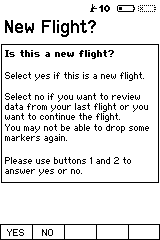 With our lately introduced newsletter we will try to inform you more actively on new versions of software and new posts on this website.
With our lately introduced newsletter we will try to inform you more actively on new versions of software and new posts on this website.
Please use the registration field in the right column to subscribe with your email address. We will not send more than a few emails per year and certainly not give the address to any third party. You can unsubscribe anytime, see link in each email.
Don’t forget to also become a member of our Facebook Group.
Instrument error correction
The FAI logger allow instrument error correction to adjust for instrument error and drift of the sensors. The instrument error adjustment is configured using a separate config file (inst_cal.cfg) which is placed on the SD card. I’ve written many emails telling officials how to do this. I think it is time to post it…
I suggest to do the correction whenever possible. If you don’t use it, make sure the
- Make sure the devices don’t have any inst_cal.cfg on the SD card and that the altitude is set to barometric. Probably best is to not use any SD card at all.
- Switch all devices on with the correct QNH. Let them heat up for 10-15 minutes
- Note the indicated altitude for all loggers.
- Use the Excel sheet to calculate the instrument error. If the reference altitude is known, it should be entered. If it is unknown, the median will be used. In that case the loggers are corrected among each other, but the absolute altitude might have some offset.
- Use the Excel sheet to create the inst_cal.cfg file. This file has the format XXX=123 with XXX being the 3-digit serial number and 123 being the altitude correction in decimeter. This value will be added to the measured altitude to get the indicated altitude. A single inst_cal.cfg file can contain the instrument error for all loggers used in the event.
- Copy the inst_cal.cfg to all SD cards or use BLM to copy it when initializing the SD card.
- Optional: Start all loggers again and check if the indicated altitude is within a small offset (Usually within 8m).
Important Note: The instrument error file on the logger is only used to adjust the indicated altitude. The altitude stored in the IGC file is not modified. Thus the same instrument error must be added during scoring. Do not use the header information in the IGC file, but use a separate database to prevent cheating possibility.
Remark: Pre 1.3.246 firmware release the file was named insterr.cfg. Based on feedback the file was renamed to inst_cal.cfg. Versions 1.3.246 and later automatically rename insterr.cfg to inst_cal.cfg if no inst_cal.cfg exists yet.
New Firmware 1.2.193
Finally I found time to release the new firmware 1.2.193. This version mainly contains a work-around for the “leap-second-issue”. The GPS time is adjusted to the real earth rotation with leap-seconds (see Wikipedia). Because the leap-second information is only transferred in a slow interval (10 minutes), we could observe since July 2012 a jump back in time of the track when this information was received.
The new firmware works around this issue and ensures that the track has a correct and smooth time for the whole recording. Additional information is available upon request.
The new firmware can be downloaded in the Official’s section.
New BLM 2.1.189
Added new feature:
– Display and export to excel of the position where a declaration was made
Fixed issues:
– Export also points with no GPS fix to BFA scoring text file
– Fixed issue with regional setting dependency of BFA scoring text export
The software can be downloaded on the BLM page.
Guidance documents
With the Scoring WG we agreed to post two guidance documents for working with the CIA loggers. The documents describe how logger handling errors were dealt with during the Europeans 2011 and give recommendations for fail-over procedures.
The documents will be discussed in the CIA forum and during the next CIA conference with the Scoring WG and eventually be included in the COH.
FAI Ballooning Commission votes more events with loggers
The FAI Ballooning Commission held it’s 2012 plenary on 23&24th of March in Birstonas, Lithuania.
All sanctioned and granted Europeans and Worlds (except Worlds 2012) intend to use the competition logger. It was accepted that the logger project is now officially out of development and test phase.
Additionally, it was strongly recommended that competition loggers should be used in all CIA Category 1 events in the future. A great confirmation and success for the project.
The following upcoming events have already confirmed to use the balloon competition loggers:
- 2012, May – 1st FAI Junior World Hot Air Balloon Championship, Marijampole (LIT)
- 2012, May – 4th Stuttgart Linde Open – 24 hours gas balloon race, Stuttgart (GER)
- 2012, July – World Balloon Trophy, Echternach (LUX)
- 2012, September – 2nd FAI Women’s European Hot Air Balloon Championship, Frankenthal (GER)
- 2012, August – 12th Debrecen Cup Int. Hot Air Balloon Competition (HUN)
- 2013 – 18th FAI European Hot Air Balloon Championship, Wroclawek (POL)
- 2014 – 1st FAI Women’s World Hot Air Balloon Championship, Leszno (POL)
- 2014 – 21st FAI World Hot Air Balloon Championship, São Carlos (BRA)
If you need more information, don’t hesitate to contact us here.
New BLM 2.1.187 / updated SignatureLib
Added new BLM with the following new features:
– Added Swedish Grid SWEREF 99 TM. (no firmware upgrade of loggers needed)
– Added Drag&Drop for opening files.
Fixes:
– Fixed issue for signature validation when IGC file contains non-ASCII characters.
Also SignatureVerifier and SignatureLib have been updated to fix the bug mentioned above (for developers only).
The software and firmware can be downloaded in the Official’s section
Big success at the Europeans in Lleida
For the first time the loggers have been used in a continental championship. At the Europeans in Lleida 77 competitors flew 7 flights and 24 tasks. A total more than 500 tracks (>1000h) have been recorded. The loggers worked flawlessly. The off/on-problem is resolved. During the whole event no pilots GPS had to be downloaded and no data was lost! A big success and important milestone for the logger project.
A new screen might pop up: “New Flight?”
 With the latest firmware upgrade of the logger a new question was introduced, that could show up at startup after entering QNH (See image).
With the latest firmware upgrade of the logger a new question was introduced, that could show up at startup after entering QNH (See image).
Pilots, don’t get confused: The question is simple: Is it a new flight or not? If you start the logger before launch or at briefing and this question rises, the answer is yes. If you want to start the logger after the flight (e.g. at debriefing) to read your declarations, the answer is no.
When a new flight is started, the logger allows you to drop all markers again and also goal declarations disappear from the user interface. Be aware that in any way you cannot clear data from your tracks. The declarations/drops done so far will remain in the track, thus scoring will not be affected.
This functionality was introduced in order to allow to reset the logger in case something went wrong with clearing the so called declaration cache. Of course pilots are not allowed to use this functionality to redrop a marker that has already been dropped in flight. Doing this might be considered interfering with the logger.
Europeans 2011 training
As you will know, the loggers will be used at the Europeans starting in less than one week. In order to allow inexperienced pilots train with the loggers, they can be borrowed for the training flights 14PM/15AM and 15PM/16AM. Find details the Europeans 2011 homepage.